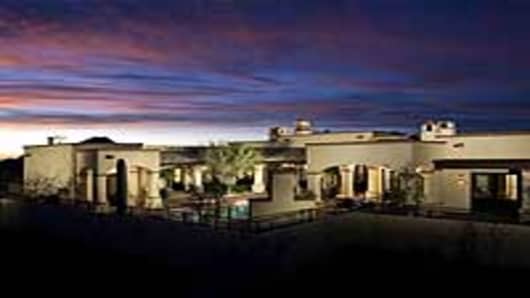Rancho San Miguel is situated in a high-end, gated golf community in Scottsdale, Ariz., that boasts several pro golfers as residents. Modeled after a classic Mexican hacienda, it totals nearly 9,000 square feet and features beamed ceilings, a full wine cellar, exercise room, hand-wrought ironwork, a heated swimming pool and a courtyard entryway. The one thing it doesn’t have, despite a reduced sale price, is a buyer.
“In the high end we always kind of thought we were immune to this stuff,” says Christy Smith, president of Casas del Oso Luxury Homes.
The homes the company builds and designs normally sell before they are completed. “After 9/11 we didn't miss a beat," says Smith. "But this time with all the stuff on Wall Street there's a lot of hesitancy.”
During the housing boom, everyone from brokers to buyers to analysts talked about how home prices almost always went up. They forgot to mention very recent periods, like in the late 80s or early 1990s, when in many US cities prices actually dropped —and in some cases stayed flat for years, meaning that in real dollars, values continued to decline.
“It started falling sharply in '88-'89 and bottomed out in ’93-94,” says Jonathan Miller, CEO and president of Miller Samuel, a New York City appraisal firm, recalling the market slump. “Then you had three or four years when it was a sideways market.”
In the current bust, prices have actually dropped more for high-end homes than for lower-priced ones.
Ken Shuman, spokesman for real estate data firm Trulia says that an analysis of homes priced at $2 million and up in June showed that, across the country, sellers reduced their prices an average of 14.3 percent. “For homes that are less than $2 million they are only dropping prices by 9.7 percent,” adds Shuman.
While buyer activity is picking up in some areas, several experts expect prices to remain flat.
“I think it's going to be a long time,” says Jim Randel, a Connecticut real estate attorney and author of "The Skinny on the Housing Crisis." In Fairfield County, Conn., he believes 90 percent of sales are taking place below $1.5 million to $2 million; two years ago, it was more like 50-50. “I don't know if that means five years, ten years or what.”
Skittishness among buyers is one reason the market will remain sluggish; a decline in savings and incomes is another. But the biggest factor is mortgage financing. Larger loans are more difficult to obtain and substantially more expensive than smaller ones.
“There is no second market for jumbo mortgages right now,” says Peter Grabel, a private mortgage banker with Luxury Mortgage, who specializes in such loans for the tri-state area and other high-end markets around the country.
Jumbos are loans that exceed the limits for mortgage securitizers Fannie Mae and Freddie Mac , and his opinion is echoed by many other experts.
“Can you get a jumbo mortgage?” Miller asks. “Of course. The question is how much do you have put down. The average is not what it used to be—it’s not 5 percent and a pulse.”
Banks are now requiring at least 25 percent down--and in some cases 30 percent--for large loans, says Brendon DeSimone, a realtor with Paragon Real Estate Group in San Francisco.Occasionally, brokers say, they are asking for 40 percent or more.
“This has really hurt the luxury market because people who used to sell stocks from their employee stock purchase plan or their portfolio no longer can count on that money because of the big hit in the stock market.”
Without a large down payment, loans are difficult to obtain or come with prohibitively high interest rates, which shrinks the pool of potential buyers and reduces demand for homes.
“Plus, the ones who have the cash are going to expect a sharper discount for the cash,” explains Miller
Grabel sees a barbell effect in the market. At the low end there is a lot of money available, thanks to federal stimulus policies and large price declines that have attracted bargain hunters.
There is activity up to the million-dollar mark, because you can buy a home for $950,000 and finance 80 to 85 percent of that with a conforming loan (the cap is $417,000 for most of the country but about $729,000 for expensive markets) and a small home equity loan, if needed.
“It’s a sweet spot,” Grabel says. “You have a [interest] rate around 5 percent and a home that might have been $1.2-$1.3 million a couple of years ago.”
Meanwhile, at the high end, there are private banks that will lend to very wealthy clients at favorable rates. "We can also get 4 or 5 percent,” he says. “They can put a lien on their jet or other home or things like that.”
The problem is the $1 million to $3 million range, where homebuyers are affluent, but not super-rich.
Though financing is the biggest challenge, other forces appear to be at work. Randel sees a paradigm shift in the way people want to live: “Smaller, more economical, less ostentatious; all bode poorly for luxury housing," he says.
In Lake Tahoe, Calif. one of the country’s premiere resort areas, Shari Chase, president and CEO of Chase International Distinctive Properties, has seen an uptick in buyers over the last 45 days, and has several large deals in the works. But she’s still advising clients to price “ahead of the market.”
“People are really scrutinizing what they’re buying, why they’re buying and what the values are,” she says. “If you have sellers that are even a smidge too optimistic they’re not going to be receiving offers.”



